Book of Durrow
The Book of Durrow is a medieval illuminated manuscript gospel book in the Insular script style. It was probably created between 650 and 700.[1] The place of creation may perhaps have been Durrow Abbey in Ireland or a monastery in Northumbria in northeastern England (where the monastery at Lindisfarne would be the likely candidate) or perhaps Iona Abbey in western Scotland—the place of origin has been debated by historians for decades without a consensus emerging.[2] The Book of Durrow was probably at Durrow Abbey by 916. Today it is in the Library of Trinity College Dublin (TCD MS 57).[3]

Description
It is the oldest extant complete illuminated Insular gospel book, for example predating the Book of Kells by over a century. The text includes the Gospels of Matthew, Mark, Luke and John, plus several pieces of prefatory matter and canon tables. Its pages measure 245 by 145 mm and there are 248 vellum folios. It contains a large illumination programme including six extant carpet pages, a full page miniature of the four evangelists' symbols, four full page miniatures, each containing a single evangelist symbol, and six pages with significant decorated initials and text. It is written in majuscule insular script (in effect the block capitals of the day), with some lacunae.
The page size has been reduced by subsequent rebindings, and most leaves are now single when unbound, where many or most would originally have been in "bifolia" or folded pairs. It is clear that some pages have been inserted in the wrong places. The main significance of this is that it is unclear if there was originally a seventh carpet page. Now Matthew does not have one, but there is, most unusually, one as the last page in the book. Perhaps there were only ever six: one at the start of the book with a cross, one opposite the next page with the four symbols (as now), and one opposite each individual symbol at the start of each gospel.[4] Otherwise the original programme of illumination seems to be complete, which is rare in manuscripts of this age.
In the standard account of the development of the Insular gospel book, the Book of Durrow follows the fragmentary Northumbrian Gospel Book Fragment (Durham Cathedral Library, A. II. 10.) and precedes the Book of Lindisfarne, which was begun around 700.
Illumination
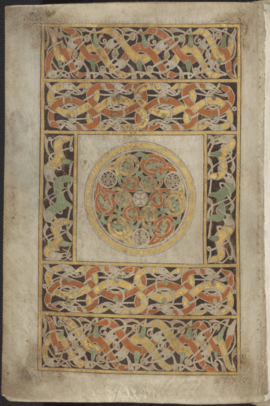
The illumination of the book shows especially well the varied origins of the Insular style, and has been a focus for the intense art-historical discussion of the issue. One thing that is clear is that the artist was unused to representing the human figure; his main attempt, the Man symbol for Matthew, has been described as a "walking buckle".[5] Apart from Anglo-Saxon metalwork, and Coptic and Syriac manuscript illustrations, the figure has been compared to a bronze figure with a panel of geometric enamel on his trunk, from a bucket found in Norway.[6]
The animal iconography derives from Germanic zoomorphic designs; the depictions of the Jesus and the Evangelists from Pictish stones. The geometric borders and the carpet pages cause more disagreement. The interlace, like that of the Durham fragment, is mostly large compared to the Book of Lindisfarne, but the extreme level of detail found in later Insular books begins here in the Celtic spirals and other curvilinear decoration used in initials and in sections of carpet pages. The page illustrated at left has animal interlace around the sides that is drawn from Germanic Migration Period Animal Style II, as found for example in the Anglo-Saxon jewellery at Sutton Hoo, and on the Benty Grange hanging bowl. But the circular panel in the centre seems, although not as precisely as other parts of the book, to draw on Celtic sources, although the three white circles at the edge recall Germanic metalwork studs in enamel or other techniques.
The Book of Durrow is unusual in that it does not use the traditional scheme, usual since Saint Jerome, for assigning the symbols to the Evangelists. Each Gospel begins with an Evangelist's symbol – a man for Matthew, an eagle for Mark (not the lion traditionally used), a calf for Luke and a lion for John (not the eagle traditionally used). This is also known as the pre-Vulgate arrangement. Each evangelist symbol, except the Man of Matthew is followed by a carpet page, followed by the initial page. This missing carpet page is assumed to have existed. A first possibility is that it was lost, and a second that it is in fact folio 3, which features swirling abstract decoration. Where the four symbols appear together on folio 2r they appear in the normal order if read clockwise, and in the pre-Vulgate order if read anti-clockwise, which may be deliberate.[7]
The first letter of the text is enlarged and decorated, with the following letters surrounded by dots. Parallels with metalwork can be noted in the rectangular body of St Matthew, which looks like a millefiori decoration, and in details of the carpet pages.
There is a sense of space in the design of all the pages of the Book of Durrow. Open vellum balances intensely decorated areas. Animal interlace of very high quality appears on folio 192v. Other motifs include spirals, triskeles, ribbon plaits and circular knots in the carpet pages and borders around the Four Evangelists.
Gallery of Evangelists' symbols
 The Man of Matthew (folio 21v)
The Man of Matthew (folio 21v)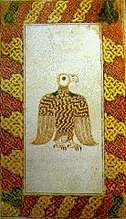 The Eagle, here of Mark, as explained above (folio 84v)
The Eagle, here of Mark, as explained above (folio 84v)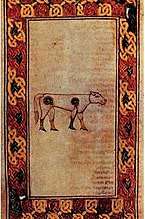 The Ox of Luke (folio 124v)
The Ox of Luke (folio 124v)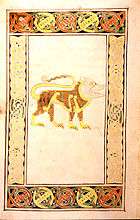 The Lion, here of John (folio 191v)
The Lion, here of John (folio 191v)
History
Origin
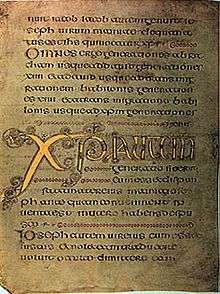
The colophon of the book (f. 247r) contains an erased and overwritten note which, according to one interpretation, is by "Colum" who scribed the book, which he said he did in twelve days. This probably relates to the belief that Colum Cille (Saint Columba) had created the book, and its date and authenticity is unclear. Twelve days is a plausible time to scribe one gospel, but not four, still less with all the decoration.[8] The earliest known cumdach, or metalwork reliquary for a book (probably an Irish innovation), was made to house and protect the Book of Durrow at the behest of King of Ireland Flann Sinna (879–916), and believed to be a relic of Colum Cille.
Preservation
A blank page contains a note by the Durrow scribe Flannchad Ua hEolais, probably from around 1100, relating to a legal dispute. The shrine was lost in the 17th century, but its appearance, including an inscription recording the king's patronage, is recorded in a note from 1677, now bound into the book as folio IIv, although other inscriptions are not transcribed. Once in the shrine it was probably rarely if ever removed for use as a book.[9]
In the 16th century, when Durrow Abbey was dissolved, the book went into private ownership. It was borrowed and studied by James Ussher, probably when he was Bishop of Meath from 1621–1623. It managed to survive during that period despite at least one section of it being immersed in water by a farmer to create holy water to cure his cows. In the period 1661 to 1682 it was given to the library at Trinity College, together with the Book of Kells, by Henry Jones while he was Bishop of Meath. The shrine and cover was lost during the occupation by troops in 1689.[10]
The five pound note of the "Series B" Irish banknotes contained an image from the book.
Gallery of carpet pages
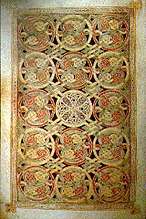 Folio 85v
Folio 85v Folio 125v
Folio 125v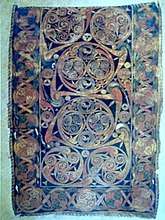 Folio 3v (ignore misleading colour values)
Folio 3v (ignore misleading colour values) Folio 1v (with holes)
Folio 1v (with holes)
See also
Notes
- O'Neill, O'Neill (1984). The Irish hand : scribes and their manuscripts from the earliest times to the seventeenth century : with an exemplar of Irish scripts. Mountrath, Portlaoise, Ireland: Dolmen Press. p. 14. ISBN 0851054110. OCLC 11957770.
- Meehan, 17-22, who seems to give Ireland the edge; Wilson, 33-36, who favours Northumbria. Both discuss the views of other scholars. Some suggest the Book of Durrow was brought to Durrow Abbey from Britain by monks who were fleeing Viking attacks in Britain.
- "IE TCD MS 57 - Book of Durrow". The Library of Trinity College Dublin. Retrieved 14 September 2018.
- Meehan, 30-38
- Wilson, 34, quoting another writer (unnamed).
- Meehan, 53 & illustration 35
- Meehan, 43-44
- Meehan, 26-28, 82
- Meehan, 13
- Meehan, 13-16
References
- Calkins, Robert G. Illuminated Books of the Middle Ages. Ithaca, New York: Cornell University Press, 1983.
- Meehan, Bernard. The Book of Durrow: A Medieval Masterpiece at Trinity College Dublin, 1996, Town House, Dublin, ISBN 1-57098-053-5
- Nordenfalk, Carl. Celtic and Anglo-Saxon Painting: Book illumination in the British Isles 600-800. Chatto & Windus, London (New York: George Braziller), 1977.
- Wilson, David M.; Anglo-Saxon Art: From The Seventh Century To The Norman Conquest, Thames and Hudson (US edn. Overlook Press), 1984.
- Walther, Ingo F. and Norbert Wolf. Codices Illustres: The world's most famous illuminated manuscripts, 400 to 1600. Köln, TASCHEN, 2005.
Further reading
- De Hamel, Christopher. A History of Illuminated Manuscripts. Boston: David R. Godine, 1986.
- Bhreathnach, Edel, ‘Observations on the Book of Durrow memorandum’, in John Carey, Kevin Murray and Caitríona Ó Dochartaigh (eds), Sacred Histories: a Festschrift for Máire Herbert, Dublin, 2015, pp. 14–21
- Henderson, George, From Durrow to Kells: the Insular Gospel-books 650–850, London, 1987
- Howlett, David, ‘The colophon in the Book of Durrow’, Hermathena, 168, Summer 2000, pp. 71–75
- Laing, Lloyd, ‘The provenance of the Book of Durrow’, Scottish Archaeological Review, 9–10,1995, pp. 115–24
- Luce, A. A. (ed.), Evangeliorum quattuor codex Durmachensis: the Book of Durrow, 2 vols, Olten, 1960
- Moss, Rachel, The Book of Durrow; Official Guide, London, 2018
- Nees, Lawrence, ‘A fifth-century book cover and the origin of the four Evangelist symbols page in the Book of Durrow’, Gesta 17:1,1978, pp. 3–8
- Netzer, Nancy, ‘The Book of Durrow: the Northumbrian connection’, in Jane Hawkes and Susan Mills (eds), Northumbria’s Golden Age, Stroud, 1999, pp. 315–26
- Netzer, Nancy, ‘Framing the Book of Durrow inside/outside the Anglo-Saxon world’, in Leslie Webster (ed.), Shaping Understanding: Form and Order in the Anglo-Saxon World, Anglo-Saxon Studies in Archaeology and History, 16 (Oxford, 2009) pp. 65–78
- Netzer, Nancy, ‘The Book of Durrow and the Lindisfarne Gospels’, in Richard Gameson (ed.), The Lindisfarne Gospels: New Perspectives (Leiden, 2017), pp. 166–82
- Nordernfalk, Carl, ‘An illustrated Diatesseron’, The Art Bulletin, 50:2 (June 1968), pp. 119–40
- Ó Cróinín, Dáibhí, ‘Merovingian politics and Insular calligraphy: the historical background to the Book of Durrow and related manuscripts’, in Michael Ryan (ed.), Ireland and Insular Art A.D. 500–1200 (Dublin, 1987), pp. 40–44
- Powell, Roger, ‘The Book of Kells, the Book of Durrow: comments on the vellum, makeup and other aspects’, Scriptorium, 10 (1956), pp. 3–21
- Roth, Uta, ‘Early Insular manuscripts: ornament and archaeology, with special reference to the dating of the Book of Durrow’, in Michael Ryan (ed.), Ireland and Insular Art A.D. 500–1200 (Dublin, 1987), pp. 23–29
- Stevick, Robert, ‘The shapes of the Book of Durrow Evangelist-symbol page’, The Art Bulletin, 68:2 (June 1986), pp. 182–9
- Werner, Martin, ‘The four Evangelist symbols page in the Book of Durrow’, Gesta, 8:1 (1969), pp. 3–17
- Werner, Martin, ‘The four Evangelist symbols page once again’, Gesta, 20:1 (1981), pp. 23–33
- Werner, Martin, ‘The cross-carpet page in the Book of Durrow: the cult of the True Cross, Adomnan and Iona’, The Art Bulletin, 72:2 (1990), pp. 174–223
- Werner, Martin, ‘The Book of Durrow and the question of programme’, Anglo-Saxon England, 26 (1997), pp. 23–39
External links
| Wikimedia Commons has media related to Book of Durrow. |
- The Library of Trinity College Online Exhibition on the Book of Durrow
- The Library of Trinity College catalogue entry
- The Library of Trinity College full digitised Book of Durrow
- Book of Durrow catalogue entry at University of North Carolina
- Treasures of early Irish art, 1500 B.C. to 1500 A.D., an exhibition catalogue from The Metropolitan Museum of Art (fully available online as PDF), which contains material on the Book of Durrow (cat. no. 27)
- More information at Earlier Latin Manuscripts